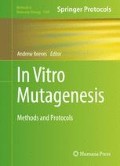Abstract
Constructing protein-coding genes with desired mutations is a basic step for protein engineering. Herein, we describe a multiple site-directed and saturation mutagenesis method, termed MUPAC. This method has been used to introduce multiple site-directed mutations in the green fluorescent protein gene and in the moloney murine leukemia virus reverse transcriptase gene. Moreover, this method was also successfully used to introduce randomized codons at five desired positions in the green fluorescent protein gene, and for simple DNA assembly for cloning.
Access this chapter
Tax calculation will be finalised at checkout
Purchases are for personal use only
References
Sen S, Venkata-Dasu V, Mandal B (2007) Developments in directed evolution for improving enzyme functions. Appl Biochem Biotechnol 143:212–223
Brustad EM, Arnold FH (2011) Optimizing non-natural protein function with directed evolution. Curr Opin Chem Biol 15:201–210
Labrou NE (2010) Random mutagenesis methods for in vitro directed enzyme evolution. Curr Protein Pept Sci 11:91–100
Reetz MT (2011) Laboratory evolution of stereoselective enzymes: a prolific source of catalysts for asymmetric reactions. Angew Chem Int Ed Engl 50:138–174
Aslanidis C, de Jong PJ (1990) Ligation-independent cloning of PCR products (LIC-PCR). Nucleic Acids Res 18:6069–6074
Dennig A, Shivange AV, Marienhagen J, Schwaneberg U (2011) OmniChange: the sequence independent method for simultaneous site-saturation of five codons. PLoS One 6, e26222
Gibson DG, Young L, Chuang RY, Venter JC, Hutchison CA 3rd, Smith HO (2009) Enzymatic assembly of DNA molecules up to several hundred kilobases. Nat Methods 6:343–345
Hogrefe HH, Cline J, Youngblood GL, Allen RM (2002) Creating randomized amino acid libraries with the QuikChange multi site-directed mutagenesis Kit. Biotechniques 33:1158–1160, 1162, 1164–1165
Hsiao K (1993) Exonuclease III induced ligase-free directional subcloning of PCR products. Nucleic Acids Res 21:5528–5529
Li MZ, Elledge SJ (2007) Harnessing homologous recombination in vitro to generate recombinant DNA via SLIC. Nat Methods 4:251–256
Tillett D, Neilan BA (1999) Enzyme-free cloning: a rapid method to clone PCR products independent of vector restriction enzyme sites. Nucleic Acids Res 27, e26
Zhang Y, Werling U, Edelman W (2012) SLiCE: a novel bacterial cell extract-based DNA cloning method. Nucleic Acids Res 40, e55
Mitchell LA, Cai Y, Taylor M, Noronha AM, Chuang J, Dai L, Boeke JD (2013) Multichange isothermal mutagenesis: a new strategy for multiple site-directed mutations in plasmid DNA. ACS Synth Biol 2:473–477
Taniguchi N, Nakayama S, Kawakami T, Murakami H (2013) Patch cloning method for multiple site-directed and saturation mutagenesis. BMC Biotechnol 13:91
Crameri A, Whitehorn EA, Tate E, Stemmer WP (1996) Improved green fluorescent protein by molecular evolution using DNA shuffling. Nat Biotechnol 14:315–319
Acknowledgments
This work was supported by the Funding Program for Next Generation World-Leading Researchers [LR011 to H.M.] and Grant-in-Aid for Scientific Research (A) [15H02006 to H.M.] from Japan Society for the Promotion of Science (JSPS).
Author information
Authors and Affiliations
Corresponding author
Editor information
Editors and Affiliations
Rights and permissions
Copyright information
© 2017 Springer Science+Business Media New York
About this protocol
Cite this protocol
Taniguchi, N., Murakami, H. (2017). Multiple Site-Directed and Saturation Mutagenesis by the Patch Cloning Method. In: Reeves, A. (eds) In Vitro Mutagenesis. Methods in Molecular Biology, vol 1498. Humana Press, New York, NY. https://doi.org/10.1007/978-1-4939-6472-7_22
Download citation
DOI: https://doi.org/10.1007/978-1-4939-6472-7_22
Published:
Publisher Name: Humana Press, New York, NY
Print ISBN: 978-1-4939-6470-3
Online ISBN: 978-1-4939-6472-7
eBook Packages: Springer Protocols

